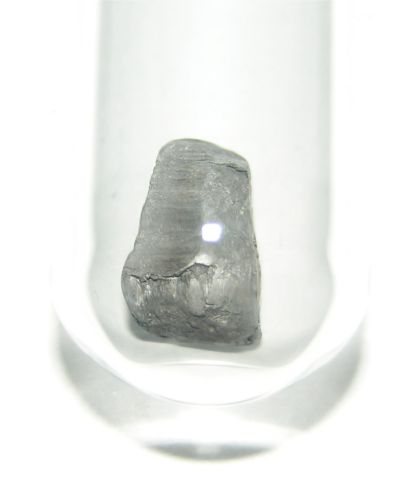Thallium
Template:Elementbox header Template:Elementbox series Template:Elementbox groupperiodblock Template:Elementbox appearance img Template:Elementbox atomicmass gpm Template:Elementbox econfig Template:Elementbox epershell Template:Elementbox section physicalprop Template:Elementbox phase Template:Elementbox density gpcm3nrt Template:Elementbox densityliq gpcm3mp Template:Elementbox meltingpoint Template:Elementbox boilingpoint Template:Elementbox heatfusion kjpmol Template:Elementbox heatvaporiz kjpmol Template:Elementbox heatcapacity jpmolkat25 Template:Elementbox vaporpressure katpa Template:Elementbox section atomicprop Template:Elementbox crystalstruct Template:Elementbox oxistates Template:Elementbox electroneg pauling Template:Elementbox ionizationenergies3 Template:Elementbox atomicradius pm Template:Elementbox atomicradiuscalc pm Template:Elementbox covalentradius pm Template:Elementbox vanderwaalsrad pm Template:Elementbox section miscellaneous Template:Elementbox magnetic Template:Elementbox eresist ohmmat20 Template:Elementbox thermalcond wpmkat300k Template:Elementbox thermalexpansion umpmkat25 Template:Elementbox speedofsound rodmpsat20 Template:Elementbox youngsmodulus gpa Template:Elementbox shearmodulus gpa Template:Elementbox bulkmodulus gpa Template:Elementbox poissonratio Template:Elementbox mohshardness Template:Elementbox brinellhardness mpa Template:Elementbox cas number |- ! colspan="2" style="background:#cccccc; color:black" | Selected isotopes |- | colspan="2" |
| iso | NA | half-life | DM | DE (MeV) | DP
Template:Elementbox isotopes stable Template:Elementbox isotopes decay2 Template:Elementbox isotopes stable Template:Elementbox isotopes end Template:Elementbox footer
Editor-In-Chief: C. Michael Gibson, M.S., M.D. [1]
Overview Thallium (Template:PronEng) is a chemical element with the symbol Tl and atomic number 81.[1] This soft gray malleable poor metal resembles tin but discolors when exposed to air. Thallium is highly toxic and is used in rat poisons and insecticides but since it might also cause cancer (although the United States EPA does not class it as carcinogen), this use has been cut back or eliminated in many countries. It is also used in infrared detectors.[2] It has even been used in some murders, earning the nicknames "The Poisoner's Poison" and "Inheritance powder" (alongside arsenic). Notable characteristicsThis metal is very soft and malleable and can be cut with a knife. When it is first exposed to air, thallium has a metallic luster but quickly tarnishes with a bluish-gray tinge that resembles lead (it is preserved by keeping it under oil). A heavy layer of oxide builds up on thallium if left in air. In the presence of water, thallium hydroxide is formed. ApplicationsThe odorless and tasteless thallium sulfate was widely used in the past as a rat poison and ant killer. In the United States and many other countries this use is no longer allowed due to safety concerns. Other uses:
IsotopesThallium has 25 isotopes which have atomic masses that range from 184 to 210. 203Tl and 205Tl are the only stable isotopes, and 204Tl is the most stable radioisotope, with a half-life of 3.78 years. Thallium-202 (half life 12.23 days) can be made in a cyclotron[7], while thallium-204 (half life 3.78 years) is made by the neutron activation of stable thallium in a nuclear reactor.[8] ToxicityThallium and its compounds are very toxic, and should be handled with great care. Contact with skin is dangerous, and adequate ventilation should be provided when melting this metal. Thallium(I) compounds have a high aqueous solubility and are readily absorbed through the skin. Exposure to them should not exceed 0.1 mg per m² of skin in an 8-hour time-weighted average (40-hour work week). Thallium is a suspected human carcinogen. Part of the reason for thallium's high toxicity is that, when present in aqueous solution as the univalent thallium(I) ion (Tl+), it exhibits some similarities with essential alkali metal cations, particularly potassium (as the atomic radius is almost identical). It can thus enter the body via potassium uptake pathways. However, other aspects of thallium's chemistry are very different from that of the alkali metals (e.g., its high affinity for sulfur ligands due to the presence of empty d-orbitals), and so this substitution disrupts many cellular processes (for instance, thallium may attack sulphur-containing proteins such as cysteine residues and ferredoxins). Thallium's toxicity has led to its use (now discontinued in many countries) as a rat and ant poison. Among the distinctive effects of thallium poisoning are loss of hair (which led it to its initial use as a depilatory before its toxicity was properly appreciated) and damage to peripheral nerves (victims may experience a sensation of walking on hot coals). Thallium was once an effective murder weapon before its effects became understood, and an antidote (prussian blue) discovered. Treatment and internal decontaminationOne of the main methods of removing thallium (both radioactive and normal) from humans is to use Prussian blue, which is a solid ion exchange material which absorbs thallium and releases potassium. The prussian blue is fed by mouth to the person, and it passes through their digestive system and comes out in the stool.[9] References
External links
|
|---|